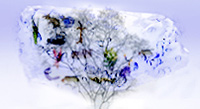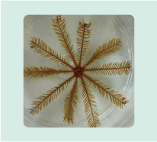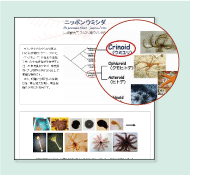BioResource Newsletter Vol.4 No.7
|
|
| Information on Resource-related Events |
 Invitation to participate in a Technical Training for the Use of Invitation to participate in a Technical Training for the Use of
Latest Bioresources (Study of transformation in Arabidopsis thaliana)
Date: September 8iMonj - September 9iTuej, 2008
Place: RIKEN Tsukuba Institute
 The 79th annual meeting of the Zoological Society of Japan The 79th annual meeting of the Zoological Society of Japan
"Symposium and Panel Exhibition"
Date: September 5iFrij - September 7iSunj, 2008
Place: Fukuoka University
 The 80th Annual Meeting of the Genetics Society of Japan The 80th Annual Meeting of the Genetics Society of Japan
"Planning to Open a Booth"
Date: September 3iWedj - September 5iFrij, 2008
Place: IB Electronic Information Hall, Nagoya University
Details are available at : http://www.nbrp.jp/ |
|
| Introduction to Resource Center No.26 |
|
 National BioResource Project National BioResource Project
"Ciona intestinalis and
Oxycomanthus japonicus"
Noriyuki SATO, Professor
Graduate School of Science, Kyoto University
|

|
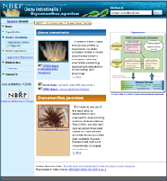
Website of NBRP
http://www.shigen.nig.ac.jp/marinebio
|
|
|
|
|
|
Aquatic invertebrates have long been used for research in various fields such as embryology, cell biology, physiology (including neurophysiology), biochemistry, reproductive biology, and evolutionary biology, and they have contributed to the accumulation of knowledge through numerous novel findings in each field of science. However, most aquatic invertebrates cannot be easily used as experimental organisms with well-investigated genetic backgrounds because of difficulties in passage breeding. The recent completion of genome sequencing of Ciona intestinalis (urochordate) and Oxycomanthus japonicus (echinoderm) has facilitated the investigation of these organisms as bioresources; projects to maintain and distribute these resources have been initiated in the form of the core facility upgrading program of the National BioResource Project (NBRP) by Kyoto University and the University of Tsukuba (Ciona intestinalis) and the University of Tokyo (Oxycomanthus japonicus).
|
|
|
|
 1. Ciona intestinalis 1. Ciona intestinalis
Sea squirts (including Ciona intestinalis) belong to phylum Chordata and are considered taxonomically important to the understanding of the origin and evolution of vertebrates (Recent studies have indicated that sea squirts belong to a sister group of vertebrates). Sea squirt tadpoles possess notochord and dorsal neural tube and are therefore considered to be representatives of the most primary and simplest chordates; they have long been used as research subjects in developmental biology to study mosaic developmental patterns.
The genome of Ciona intestinalis was sequenced at the end of 2002; it was the 7th genome to be sequenced among animal species. The approximately 16,000 genes predicted in the 160-Mbp genome represent the fundamental gene composition of chordates before genome-wide gene duplication occurred twice in vertebrates. Moreover, because of a large-scale EST/cDNA project conducted in parallel with the genome-sequencing project, the cDNA resources of Ciona intestinalis have become one of the most comprehensive collections among invertebrates.
Consequently, genome-wide analyses of various biological phenomena have advanced rapidly. For example, progress is expected in genome-wide analyses related to the prospective fate of cells in early development and environmental responses, comprehensive analyses of neural functions, and functional analyses of channel molecules and neural peptides.
Wild-type and inbred strains of Ciona intestinalis are being maintained at and distributed by Kyoto University. In addition, inbred strains with higher purity are also being established. The procedure for breeding the strains is outlined as follows:
| |
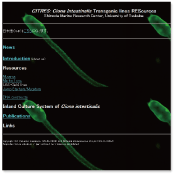
CITRES Home
http://www.shimoda.tsukuba.ac.jp/~ciona/
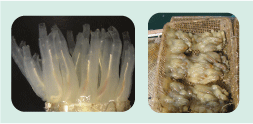
Fig.P:Ciona intestinalis adhered to a plastic plate to be maintained and distributed (left) and a breeding site (right). |
|
|
Sea squirts are fertilized once every 2 weeks and the larvae thus developed are attached to plastic plates (9 cm in diameter).
The larvae are fed and their development is observed for 2-3 weeks following which they are culled with only 12-15 healthy individuals allowed to survive.
These larvae are nurtured by suspending them in the sea at the float bridge of an aquatic laboratory in Maizuru (Fig. 1)
After 2-3 months, the grown-up adult animals are distributed to the users.The sea squirts have been distributed to researchers every Monday. Approximately 20,000 sea squirts were distributed from August 2007 to March 2008. As a result, even though the availability of Ciona intestinalis was restricted to early summer and fall due to limited availability of natural resources, users were now able to access a steady supply of Ciona intestinalis for research throughout the year.
|
|
 2. Transgenic strain resources of Ciona intestinalis 2. Transgenic strain resources of Ciona intestinalis
A technique to develop transgenic strains of Ciona intestinalis by inserting exogenous DNA into the genome using Minos transposons was established at the University of Tsukuba. Marker strains expressing larval or adult tissue-specific fluorescent proteins such as GFP were constructed using this technique. Moreover, a method of developing mutant strains by knocking-out a gene by inserting Minos transposons and an enhancer-trap method were introduced in Ciona intestinalis. The enhancer-trap method is particularly effective due to the compactness of the Ciona intestinalis genome. Furthermore, a system to develop enhancer-trap strains on a large scale by crossing strains expressing transposases with those having inserted transposons has been established; in this manner, various marker strains have been constructed by using this system (Fig. 2).
At the Shimoda Marine Research Center, University of Tsukuba, which is a sub-institute of the project, breeding rooms with a capacity to maintain approximately 6,000 Ciona intestinalis individuals were constructed (Fig. 3). Here, transgenic strains are collected, maintained, and distributed upon request. Large amounts of seawater are required to breed Ciona intestinalis; therefore, its maintenance is particularly difficult for inland research groups. By utilizing the advantages of our marine laboratory, we hope to support sea-squirt research by breeding, maintaining, and distributing sea-squirt strains to the groups facing difficulties in maintaining sea squirts.
Currently, 47 strains are being maintained for NBRP. Among these, 11 tissue-specific marker strains, 31 enhancer-trap strains, and 1 mutant strain are available for distribution. Information on these strains is available at our website, CITRES (http://www.shimoda.tsukuba.ac.jp/~ciona/index.html). We hope that potential users of these strains would access the website and browse through the collection of the strains. We also appreciate email inquiries (to Sasakura: sasakura@kurofune.shimoda.tsukuba.ac.jp) regarding the strains that are not listed on the website.
|
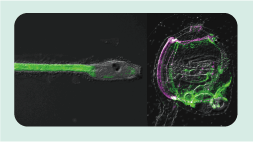
|
|
Fig. 2: Transgenic strains of Ciona intestinalis expressing GFP. A strain expressing GFP in the muscle of a larva (left) and an enhancer-trap strain expressing GFP and RFP in the endoderm (green) and endostyle (magenta), respectively, of the body of a larva after transformation (right). |
|
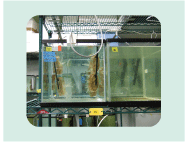
Fig. 3: Breeding of sea squirts
|
 3. Oxycomanthus japonicus 3. Oxycomanthus japonicus
Oxycomanthus japonicus (Fig. 4) belongs to Crinoidea (sea lilies), which is evolutionarily the oldest among existing echinoderms. Sea urchins have been conventionally used as a representative of echinoderms; however, most echinoderms, except sea lilies, have lost several important traits such as the central ganglion commonly observed in deuterostomes. Therefore, sea urchins are not necessarily an appropriate representative of this group. Sea lilies possess a central ganglion composed of approximately 1,000 cell bodies and are used for researches on the origin and evolution of the central nervous system of deuterostomes. It was implied that the central ganglion is responsible for regulating complex and quick motions of the arms; the thick nerve cords that radially extend from the central ganglion are involved in cell accumulation and differentiation of a regenerating bud in the process of arm regeneration.
At the Misaki Marine Biological Station, the University of Tokyo, the roles of the Elav, Otx, Pax6, and Hox gene clusters in the development of central ganglion in sea lilies were analyzed. In sea urchins, the genes located upstream of the Hox cluster are significantly different; these genes are either translocated to the end of the cluster or are inverted, and only the genes in the downstream region exhibit an expression pattern corresponding to the anterior-posterior axis. Interestingly, in Oxycomanthus japonicus, the genes located on the upstream region including Hox1 are expressed in the early developmental stage. The structure of the Hox cluster was also analyzed using a BAC library.
A high regenerative capacity and the involvement of the nervous system in regeneration are some of the most significant advantages of Oxycomanthus japonicus as an experimental animal. Currently, expression analyses of Vasa and PL10, which are the indicators of pluripotency of the cells, and the comprehensive isolation of gene clusters involved in regeneration, especially those expressed in the central ganglion in the regeneration process, are being attempted. In addition, arm tissues exhibit segmental structures composed of muscle-, ligament-, and bone-tissue units and are thus useful in comprehending the evolution and ubiquitous nature of the segmentation mechanism observed in deuterostomes. Homologues involved in the segmentation of vertebrates, such as the Notch-Delta system and hairy, are being isolated and analyzed.
In this project, the cDNA library and EST information of central ganglion were collected and made available for distribution. Moreover, fixed embryos, larvae, adults, cDNAs, and genome DNAs were also made available.
|
|

|
|
Coming up in the next issue !
The special topic on resources discussed in the
next month's issue will be "Lotus / Glycine". |
|
|
 Ratproxy--A tool to inspect vulnerability of web applications Ratproxy--A tool to inspect vulnerability of web applications
|
According to "Reporting Status of Vulnerability-related Information on Software Products and Websites, 2nd Quarter of 2008 (April-June)" published on July 15, 2008 by the Information-Technology Promotion Agency (IPA), Japan, two-thirds of all the reports on software vulnerability are related to websites. ?Moreover, according to the breakdown of the types of vulnerabilities in websites, cross-site scripting (XSSÎ) was at the top with 68% and unintended file disclosure in 2nd place with 18%, (http://www.ipa.go.jp/security/vuln/report/vuln2008q2.html in Japanese).
Accordingly, I would like to introduce "ratproxy", a tool to inspect the vulnerability of web applications. Ratproxy is an open-source software released on July 1, 2008, which was originally used internally by Google and is capable of detecting possible existing vulnerability primarily related to XSS. Compatible OSs are Linux, FreeBSD, MacOS X, and Windows (Cygwin). In this test, ratproxy was used by installing it on Linux (Fedora Core 6). (http://googleonlinesecurity.blogspot.com/2008/07/meet-ratproxy-our-passive-web-security.html)
Î XSS c A type of vulnerability found in web applications that display the input from a user without validating it such as bulletin boards, thus resulting in malicious codes being sent to other users' browser.
y Excerpted from IT Terminology Dictionary e-Words (http://e-words.jp/) and partially modified z
|
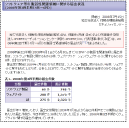
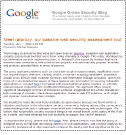 |
|
Let's use the tool !
@ After downloading ratproxy, decompress the file and configure it as follows:

A Run ratproxy and specify the output directory of the log file.
B Change the proxy settings for the web browser which you will use to test the vulnerability of the web application. Here, I am using the web browser in the computer which I have installed ratproxy; therefore I will specify "localhost" as the IP address and "8080" as the the port number on the proxy settings screen.
C After you have changed the proxy settings, use that web browser to visit the website that you wish to test. |
|
D Terminate the ratproxy program by pressing "Ctrl + c".
 E The result can be obtained as an HTML file using ratproxy-report.sh.

F The output file from the browser lists the possible existing vulnerabilities according to their categories and risk levels as shown on the right. Please note that some changes will be necessary if you install ratproxy on Windows (Cygwin). Let us use ratproxy once and see its usefulness!
|
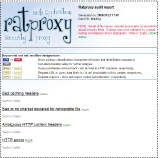
|
(Gaku KIMURA)
|
|
|
Editor's NoteF The concept of a model organism is obviously not inherent in nature. A model organism in a research field achieves its status on the basis of someone's publication of unique and attractive research achievements relevant to that organism that cannot be obtained using other organisms; this increases the number of researchers working on the organism and accordingly leads to the accumulation of knowledge concerning it. Even if an organism exhibits the potential to be a model organism, the increase in the number of researchers using it depends greatly on the availability and manageability of the organism.
The projects involved in the maintenance and distribution of sea squirts and sea lilies are now addressing these problems. The distribution of 20,000 sea squirts to researchers in 8 months while breeding them in the sea is really incredible ! (Y. Y.)
|
Contact AddressF
1111 Yata, Mishima-shi, Shizuoka 411-8540, Japan
Center for Genetic Resource Information, National Institute of Genetics
Tel: 055-981-6885 (Yamazaki)@
E-mail brnews@chanko.lab.nig.ac.jp
"translated by ASL translation service and proofread by Sharoh Yip" |
|
|
